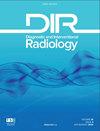Operator learning curve for transradial liver cancer embolization: implications for the initiation of a transradial access program.
IF 2.1
4区 医学
Q2 Medicine
引用次数: 13
Abstract
PURPOSE To analyze transradial approach (TRA) learning curve on patients undergoing hepatic chemoembolization, investigating the relationship between procedural volumes and various benchmarks of procedural success. METHODS We enrolled sixty consecutive patients who received two unilobar hepatic chemoembolization within a 4-week interval performed by a single interventional radiologist, highly-trained in conventional transfemoral procedures (TFA), but without any previous practical experience in TRA procedures and with a preliminary 2-days theoretical training only. We divided the study population, prospectively consecutively random-enrolled, into 3 groups: A (case 1 to 20), B (case 21 to 40), and C (case 41 to 60), using all TFA procedures performed by the same operator in the same series of patients as the control group. Primary endpoint was to analyze the relationship between TRA procedure operator experience and benchmarks of procedural success, to define the optimal procedural learning curve. RESULTS Technical success was obtained in all patients, with a cross-over rate (radial to femoral access) of 0%. An association between incremental TRA operator experience (in terms of performed procedures) and decrease of preparation, puncture, fluoroscopy, and total examination times was observed. Similarly, inverse associations between incremental TRA operator experience and contrast medium (CM) volumes (P < 0.001) and radiation dose (RD) values (in terms of RAK - Reference Air Kerma) (P < 0.001) were also observed. Compared to TFA, CM volumes and RD values were significantly higher only in group A (1-20). Procedure success remained high in all TRA groups and no significant association between TRA incremental experience and post-procedural outcomes was found. Higher post-procedural complaints at the access route and more limitations in performing basic activities were recorded in TFA vs TRA patients (P < 0.001). CONCLUSION TRA catheterizations can be safely performed in patients treated for liver cancer embolization after a relatively short training in controlled conditions and with a better performance in comparison with TFA. Operator proficiency improves with greated TRA experience, with a threshold needed to overcome the learning curve represented by about 20 procedures.经桡动脉肝癌栓塞术的操作人员学习曲线:对经桡动脉栓塞程序启动的影响。
目的分析肝化学栓塞患者的经桡动脉入路(TRA)学习曲线,研究手术量与手术成功的各种基准之间的关系。方法我们招募了60名连续的患者,他们在4周内接受了两次单叶肝化学栓塞治疗,由一名受过传统经股动脉手术(TFA)高度训练的介入放射科医生进行,但之前没有任何TRA手术的实践经验,只接受了为期2天的初步理论训练。我们将前瞻性连续随机入选的研究人群分为3组:A组(病例1至20)、B组(病例21至40)和C组(病例41至60),使用同一操作员在同一系列患者中进行的所有TFA程序作为对照组。主要终点是分析TRA程序操作员经验与程序成功基准之间的关系,以确定最佳程序学习曲线。结果所有患者均获得了技术上的成功,交叉率(桡骨至股骨通路)为0%。观察到TRA操作员经验的增加(就所执行的程序而言)与准备、穿刺、荧光透视和总检查时间的减少之间的关联。同样,TRA操作员的增量经验与造影剂(CM)体积(P<0.001)和辐射剂量(RD)值(根据RAK-参考空气Kerma)(P<001)之间也存在负相关。与TFA相比,只有A组(1-20)的CM体积和RD值显著更高。所有TRA组的手术成功率仍然很高,TRA增量经验与术后结果之间没有发现显著关联。TFA与TRA患者在进入途径上的术后投诉较高,基本活动受限较多(P<0.001)。结论接受癌症栓塞治疗的患者在受控条件下经过相对较短的训练后,可以安全地进行TRA插管,与TFA相比,其表现更好。操作员的熟练程度随着TRA经验的丰富而提高,需要一个阈值来克服由大约20个过程表示的学习曲线。
本文章由计算机程序翻译,如有差异,请以英文原文为准。
求助全文
约1分钟内获得全文
求助全文
来源期刊
CiteScore
3.50
自引率
4.80%
发文量
69
审稿时长
6-12 weeks
期刊介绍:
Diagnostic and Interventional Radiology (Diagn Interv Radiol) is the open access, online-only official publication of Turkish Society of Radiology. It is published bimonthly and the journal’s publication language is English.
The journal is a medium for original articles, reviews, pictorial essays, technical notes related to all fields of diagnostic and interventional radiology.

 求助内容:
求助内容: 应助结果提醒方式:
应助结果提醒方式:


